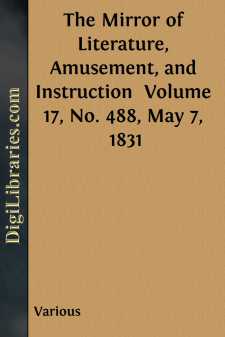Categories
- Antiques & Collectibles 13
- Architecture 36
- Art 48
- Bibles 22
- Biography & Autobiography 813
- Body, Mind & Spirit 142
- Business & Economics 28
- Children's Books 17
- Children's Fiction 14
- Computers 4
- Cooking 94
- Crafts & Hobbies 4
- Drama 346
- Education 46
- Family & Relationships 57
- Fiction 11829
- Games 19
- Gardening 17
- Health & Fitness 34
- History 1377
- House & Home 1
- Humor 147
- Juvenile Fiction 1873
- Juvenile Nonfiction 202
- Language Arts & Disciplines 88
- Law 16
- Literary Collections 686
- Literary Criticism 179
- Mathematics 13
- Medical 41
- Music 40
- Nature 179
- Non-Classifiable 1768
- Performing Arts 7
- Periodicals 1453
- Philosophy 64
- Photography 2
- Poetry 896
- Political Science 203
- Psychology 42
- Reference 154
- Religion 513
- Science 126
- Self-Help 84
- Social Science 81
- Sports & Recreation 34
- Study Aids 3
- Technology & Engineering 59
- Transportation 23
- Travel 463
- True Crime 29
The Mirror of Literature, Amusement, and Instruction Volume 17, No. 488, May 7, 1831
by: Various
Categories:
Description:
Excerpt
ST. GEORGE'S CHAPEL, WINDSOR.
This venerable structure, as we explained in No. 486 of The Mirror, is situated in the lower ward or court of Windsor Castle. It stands in the centre, and in a manner, divides the court into two parts. On the north or inner side are the houses and apartments of the Dean and Canons of St. George's Chapel, with those of the minor canons, clerks, and other officers; and on the south and west sides of the outer part are the houses of the Poor Knights of Windsor.
The Engraving represents the south front of the Chapel as it presents itself to the passenger through Henry the Eighth's Gateway, the principal entrance to the Lower Ward. The entrance to the Chapel, as shown in the Engraving, is that generally used, and was formed by command of George the Fourth; through which his Majesty's remains were borne, according to a wish expressed some time previous to his death.
The exterior of the Chapel requires but few descriptive details. The interior will be found in our last volume.
It is a beautiful structure, in the purest style of the Pointed architecture, and was founded by Edward the Third, in 1377, for the honour of the Order of the Garter. But however noble the first design, it was improved by Edward the Fourth and Henry the Seventh, in whose reign the famous Sir Reg. Bray, K.G., assisted in ornamenting the chapel and completing the roof. The architecture of the inside has ever been esteemed for its great beauty; and, in particular, the stone vaulting is reckoned an excellent piece of workmanship. It is an ellipsis, supported by lofty pillars, whose ribs and groins sustain the whole roof, every part of which has some different device well finished, as the arms of several of our kings, great families, &c. On each side of the choir are the stalls of the Sovereign and Knights of the Garter, with the helmet, mantling, crest, and sword of each knight, set up over his stall, on a canopy of ancient carving curiously wrought. Over the canopy is affixed the banner of each knight blazoned on silk, and on the backs of the stalls are the titles of the knights, with their arms neatly engraved and emblazoned on copper.
There are several small chapels in this edifice, in which are the monuments of many illustrious persons; particularly of Edward, Earl of Lincoln, a renowned naval warrior; George Manners, Lord Roos, and Anne, his consort, niece of Edward the Fourth; Anne, Duchess of Exeter, mother of that lady, and sister to the king; Sir Reginald Bray, before mentioned; and Charles Brandon, Duke of Suffolk, who married the sister of King Henry the Eighth.
At the east end of St. George's Chapel is a freestone edifice, built by Henry the Seventh, as a burial-place for himself and his successors; but afterwards altering his purpose, he began the more noble structure at Westminster; and this remained neglected until Cardinal Wolsey obtained a grant of it from Henry the Eighth, and, with a profusion of expense, began here a sumptuous monument for himself, whence this building obtained the name of Wolsey's Tomb House....












